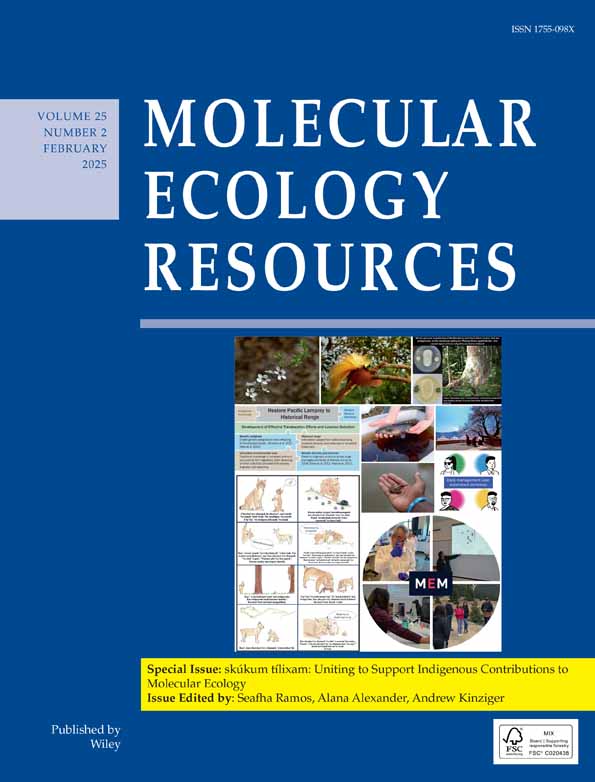Sharing biological information across generations: Parallels between indigenous knowledge and genetics for fisheries recovery in the Columbia River Basin
Abstract
enIndigenous tribes of the interior Columbia River have developed a mutual relationship with native fishes since time immemorial. However, extensive disruption to the natural ecosystem has occurred as European settlement of North America extended westward to utilize abundant natural resources in ways that conflicted with millennia of indigenous protection. This anthropogenic disturbance has led to dramatic declines in native fish species that are central to tribal cultures, but efforts are underway to enable these fishes and the people that rely upon them to persist for future generations. Here, we describe how pairing indigenous knowledge and western science have been applied to assist with fisheries recovery in the Columbia River. Parallel understanding of information passed across generations is central to this effort, from tribal elders with their historical grasp of the natural ecosystem and fisheries, to molecular genetic approaches that track DNA that is passed from parents to offspring and subsequent generations. Examples are provided that illustrate how both indigenous knowledge and genetic tools have been applied to support fisheries recovery in the Columbia River Basin.
Sahaptin (Ičɨškíinki)
yakThis writing is in the native Sahaptin Language (Ičɨškíinki) so you the Salmon People will know what is written. Sahaptin is a shared language among the Columbia River Treaty Tribes. Translation was provided by Fred Hill, tribal member of the Confederated Tribe of the Umatilla Indian Reservation. Čí Tímat iwá Ičɨškíinki, ku imáy Waykanšłáma pam ášukʷata anatún iwá tímani. Míimi, anakú iwačá, Nusuxyáy išápatutiya wat̓ičɨn Aniłaanmíyaw, ku isíniwiya, iˀáwɨna, ínaš áwapatatta Natítaytma anamún úyt pa wíyanawita íčɨn čná tičámpa. Ku kúšxi pamáyxi papánaknuwitaaš inmína Wáwnakšaš, Tamná ku Wak̓íšwit. Čí iwá Tamáanwitki ku Čínči łk̓ʷíkni aykúš iwáta. Áypam áw šúqʷaša čí múł walcáycas tamnanáxtna ana mišní náamɨn Natítaytma nawá čná tičámpa číˀaw kúuk. Yáanwa Natítaytma, nč̓í wánakni pawačá šapášuqʷani, pawá Waykánašpamłaamɨn, ku túnx núsux waníči pa naknuwíya tanánma. Awkú míimi anamún šuyápuma pa wíyanawiya čná tičámpa, áw ƛáwx tún pašapátunxwiya, pawíwɨnpɨn tičám ƛáwx máan ku pa wítmiwna papák̓ɨnkta nč̓í wánana pák̓ɨnktpamaki, ániyaytaš xtúwit láxayxitpamayaw ƛáawx máan tičámpa. Anakú mún pa pátukaya łak kutkutpama ƛáawx máan, páyu pašapátatiiya nč̓í wánana anatún mɨláa pa áˀk̓aatɨnxana nč̓í wánapa. Ku kúšxi palaláay núsux paklíwiya kʷanáa ay sapaxaluut̓áwaski. Ku múłsim taš nawačá núsux nč̓í wánapa aymún. Anamún papátukɨn nč̓í pák̓ɨnktpama nč̓í wánapa, awkú čawtáy áwača tunínitaš waykáanašna šapáˀituxt áyataš. k̓ʷáyxʷɨšt wíwača úyt anamún palaláay šuyapuma pa táwyanayka ƛáawx máan nč̓í wanapáynpa. Awkú waykánaš pawá natitaytmí áwtni tqʷátat, ku aykúš iwá áxway čiˀaw kúuk. Awkú číˀaw kúuk áwa łakníin šapátkutkut šapáˀituxtaš wakáanašna namí wána ku wálapa. Iwá ƛáawxmamí ku miyanašmíyay. Awkú napuˀin Tanán ku šuyápuma napáwiyalaxsimiša šapášuk̓ʷatna áwapaatatˀay wakánašna. Ku ƛáawx tún waykanašmí wiyáxayxtna, pa ítitamayša, anakuˀúš pa táaˀanxa DNA-ki. Awpa aˀšuk̓ʷaša nusuxmí ttáwaxt atwanatas ̌ku kúšxi panmiin spáytit DNA-ki. Awkú namí nč̓íˀnč̓imaamɨn míimi pašúkwana šapánaknuwit waykáanaš ku k̓súyasna, Awkú čikúuk šapásukʷatki pa kútkutnayša núsux ku k̓asúyas šapáˀituxtaš. Ku čí ititámat kutkut iˀísiqʷaša anamayní CRITFC ku Nč̓í Wanałáma Tanáma pa kútkutnayša.
1 INTRODUCTION
Local adaptation in species develops through long-term exposure to the environment where selection drives fitness of populations to an optimum for local conditions. In a parallel process, Indigenous knowledge has been acquired through living and thriving over millennia, which is passed through generations to continually adjust subsistence practices for optimal success. Both systems record and leverage past success to devise strategies for the future and maintain capacity to adjust to environmental changes caused by frequent short-term disturbances (e.g., fire, landslide, earthquakes, volcanic eruptions) or long-term shifts in geology (e.g. refugia during periods of glaciation). Such disturbances are common around the northern Pacific Rim and evidence supports successful adaptation of species in these ecosystems through natural selection (e.g. Taylor, 1991) and indigenous practices that ensure persistence (e.g. Reid et al., 2022).
Over thousands of years, native tribes have developed a holistic relationship with the earth, water, plants and animals that make up the natural ecosystem. Native fishes appeared in the fossil record millions of years ago and predate many other organisms, such as Pacific lamprey (450 Ma), white sturgeon (200 Ma), salmonids (6 Ma) that occurred long before humans (Figure 1a). Since the last ice age, native peoples and Pacific salmon have co-existed in the Pacific Northwest of the North American continent through adaptation to local environments over geological time scales. Over that time, Pacific salmon differentiated into various lineages where species optimized available habitat through complex life history strategies (Allendorf et al., 1987; Quinn, 2021).
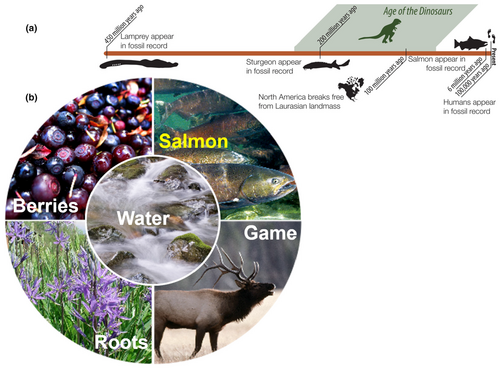
Indigenous knowledge (IK) has developed over many generations to optimize sustainable use of natural species for subsistence purposes, often referred to as “First Foods” by native tribes (Figure 1b). As described by Quaempts et al. (2018), the concept is focused on a reciprocity-based approach to natural resources where humans ensure resilience of organisms and the environment that provide subsistence over generations. This First Foods concept is maintained in serving rituals of traditional meals that are centered around water as the beginning and end of ritual meals, followed by a serving order of salmon, wildlife (big game), roots, and berries with all of these foods providing critical cultural resources for native tribes (Quaempts et al., 2018).
In the Columbia River Basin, salmon are a priority in First Foods concept and many indigenous tribes are considered salmon people, Wykanushpum, who have developed a mutual relationship with native fishes. Several aquatic species have a role in indigenous cultures (Figure 2) such as salmonids (Oncorhynchus spp.), lamprey species (Entosphenus tridentatus and Lampetra spp.), white sturgeon (Acipenser transmontanus) and freshwater mussels (e.g. western pearlshell Margaritifera falcata; western ridged mussel Gonidea angulate). However, the multiple species of Pacific salmon that return annually to the Columbia River from spring through fall have been central to tribal cultures (Quaempts et al., 2018). These salmon species provided subsistence for regional tribes, and knowledge was passed over generations on best practices for harvesting fish but also protecting runs of salmon for future sustainability.
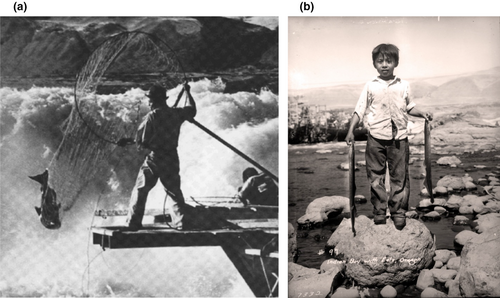
While this ecosystem historically experienced natural fluctuations through climate cycles and natural disasters, extensive disruption has occurred as European settlement of North America extended to the Columbia River Basin. Newly established colonies in the 1800's sought to utilize abundant natural resources in ways that conflicted with millennia of indigenous protection. This anthropogenic disturbance has led to dramatic declines in native fish species that are central to tribal cultures. Treaties of 1855 between the US government and indigenous tribes formally extended tribal rights to harvest fish in their usual and accustomed manner, however anthropogenic disturbance accelerated the decline of salmon fisheries for several decades following these treaties (Figure 3). The causes of decline are well documented and include extreme overharvest, extensive habitat degradation, and development of a vast hydro-system that greatly altered anadromous salmonid migration corridors and limited or excluded access to natural spawning areas (Williams et al., 1999; Gustafson et al. 2007). Hatchery programs were implemented with the intent to mitigate for the loss of populations, but have never been able to return salmon species to a status that fully meets subsistence needs of tribes in the region. In recent decades, the abundance of salmon species represents a small fraction of their original numbers, while future scenarios of climate change (Crozier et al., 2021; Keefer et al., 2018) and consequences of population expansion (Lackey, 2022) are expected to lead to further extirpation events or extinction of natural salmonids.
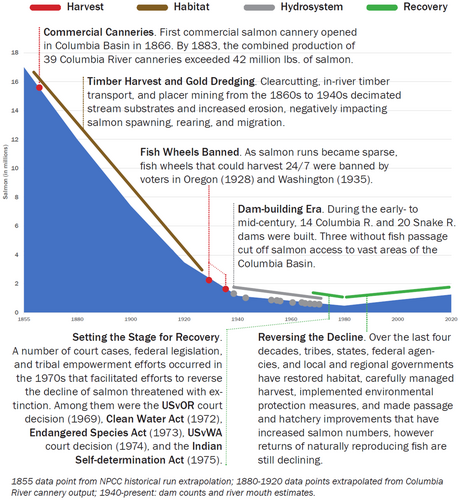
These declines in salmonid abundance have led to extensive recovery efforts in the Columbia River Basin, with increased focus on tribal led programs in recent decades. Recognition of indigenous knowledge has also increased in recent years including formal guidance on citations in scientific studies (MacLeod, 2021). Tribal led programs for fisheries recovery have paired multiple aspects of Indigenous Knowledge and Western Science in efforts to achieve objectives. This philosophical approach to fisheries recovery emphasizes co-existence of multiple knowledge sources that aims to recognize and value the unique insights provided from different cultures. This concept has been formally described in various indigenous cultures and is often referred to as “two-eyed seeing” as initially described by Albert Marshall in 2004 as an elder of his indigenous tribe (Bartlett et al., 2012). The formal application of this concept to fisheries was recently described by Reid et al. (2021) with further scenarios for evolution and ecology presented by Jessen et al. (2021). In this study we focus on implementation of this concept for fisheries recovery in the Columbia River Basin. Specifically, the parallels between indigenous knowledge and genetics to transfer information over generations. Examples are provided in recovery efforts for native fish species that are vital to the ecosystem and have been traditional foods for regional tribes for millennia.
2 CO-EXISTENCE OF KNOWLEDGE SOURCES AND CONTRIBUTIONS TO MOLECULAR ECOLOGY
Co-existence of multiple knowledge sources has yielded unique insights in fisheries (e.g. Reid et al., 2021), and natural parallels exist between indigenous knowledge and genetic science since both achieve common understanding of information passed over generations (Figure 4a). Indigenous knowledge of Wykanushpum (salmon people) in the Columbia River Basin has centered around transfer of information to subsequent generations including critical details that have enabled effective subsistence fisheries for millennia including species distributions, abundance, seasonal timing, and harvest methods. Effective harvest locations were refined over generations for seasonal runs of Chinook Salmon including at historical sites such Celilo Falls and Kettle Falls on the mainstem Columbia River (Dupris et al., 2006). Since time immemorial, these sites and many others became important locations for tribes in the region for gathering food that would help sustain tribal families throughout the year (e.g. Matsaw, 2020; Quaempts et al., 2018). Indigenous tribes, IK systems, and locally adapted salmon all co-evolved on the same landscape. Both humans and salmon have pathways that allow geographic knowledge to be transmitted between generations: IK through cultural traditions and stories; salmon through homing mechanisms that ensure reproductive success over generations.

As tribal fishers spent months at harvest sites like Celilo Falls, specific insights from indigenous knowledge were retained over generations such as the largest and oldest Chinook Salmon returned in early summer months (Figure 4b). Chinook Salmon, “tkʷínat núsux” (Umatilla language), of large size became highly prized by tribal fishers providing incentive for this key piece of information to be passed to family members. In recent decades, genetic monitoring programs of Chinook Salmon in the Columbia River have identified genetically distinct groups along with their return timing that is consistent across generations (Hess & Narum, 2011; Narum et al., 2010). Further, major effect genes for return timing in Chinook Salmon have been identified that explain up to 80% of phenotypic variation in adult migration across seasons (Narum et al., 2018; Willis et al., 2021). The identification of heritable genes responsible for these traits supports indigenous knowledge that the largest and oldest fish return in summer months across generations. Both knowledge sources have arrived at similar inferences, and provide critical information for context specific management decisions to ensure persistence of phenotypic variation in this species (e.g. Waples et al. 2022).
Beyond Chinook Salmon, more extensive indigenous knowledge of biological events related to seasonal timing (“seasonal rounds”) was developed to all organisms within the natural ecosystem of the Columbia River Basin (Figure 4c). These “seasonal rounds” were developed in tribal cultures that depended on these different species for survival and established a vital connection to all living things that came from the water and earth. This connection to the ecosystem and timing of biological events was a key component of indigenous knowledge that was passed for over generations. In western science, the timing of biological events (phenology) has been documented across species along with the interconnectivity of species within the ecosystem. Western studies of phenology in native species of the region (e.g. Middleton et al., 2013; Tillotson et al., 2021) align well with the indigenous concept of “seasonal rounds”, with clear connections between timing of biological events and optimal harvest periods of traditional foods that have supported regional tribes (e.g. Carney et al., 2021; Matsaw, 2020). Further, both knowledge systems emphasize the interdependence of organisms within an ecosystem with indigenous understanding on connectivity of various species (e.g. Watkinson 2000; Turner & Reid, 2022), and western science that has linked the presence of diverse species from microbes (Grossart et al., 2020) to salmon (Cederholm et al., 1999) that influence the health of aquatic ecosystems. Ongoing studies have developed community metagenomics and environmental DNA (“eDNA”) tools that have further enlightened our understanding of species composition by collecting water and soil samples to monitor biodiversity in aquatic ecosystems (e.g. Rodríguez-Ezpeleta et al., 2021). These holistic views are complementary to one another and highlight the need for fully functional ecosystems for a combination of species to persist.
3 APPLICATIONS TO RECOVERY OF NATIVE FISHES
3.1 Example 1: Columbia River fisheries management
The historical site of Celilo Falls on the mainstem Columbia River (now inundated and no longer visible just upstream of The Dalles Dam) has been described by tribal elders as operating as the economic centre of the Columbia River. Such was the importance of that site to the villages and surrounding tribes that utilized it for its prime fishing opportunity. During the Celilo Falls era, tribal elders would use cues from the arrival and strength of the runs to initiate First Salmon Ceremonies (Dupris et al., 2006). These ceremonies were tied to each location on the river with longhouses furthest downstream scheduling the earliest harvest celebrations of spring Chinook Salmon, followed by by villages and tribes distributed further upstream. There were also days of rest which were established by tribal elders to allow for some salmon to pass Celilo Falls without harvest pressure to provide for harvest opportunities of tribal peoples further upstream as well as to provide healthy numbers of fish to return to spawning grounds in headwaters.
Today, Celilo Falls does not exist as a fishing site, however the four Columbia River Treaty tribes are co-managers of the fisheries in the Columbia River and as such, they help to shape fisheries management and are guided by tribal elders who have retained some of the same values and thinking that guided ancient management practices at Celilo Falls. In many places around the world, fisheries management involves a variety of stakeholders (including public, non-profit organizations, state and federal management entities, etc.) that have opportunity to provide input that may or may not be integrated into final management decisions. However, the Columbia River Treaty tribes are co-managers and active participants in yearly planning that shapes the fisheries that are executed in the Columbia River. The First Salmon ceremonies still take place prior to any commercial fisheries openings, and during the summer period, commercial fishery openings are often scheduled on weekdays while often leaving Sunday as a day of rest.
Fisheries management decisions integrate the priorities and values of tribal elders through a process in which fisheries management staff bring together the best available science, a guiding policy framework established by state, federal and tribal co-managers (i.e. U.S. v OR Management Agreement), and up-to-date trends in the abundance of management units; and present this information to representatives of each of the Columbia River Treaty Tribes to shape salmon fisheries (Figure 5; Hargrove et al., 2021). Part of this “best available science” relies on routine monitoring and collections of biological data at the Adult Fish Facility at Bonneville Dam. This facility collects representative samples of each run of fish (i.e. Spring, Summer, and Fall Period Chinook Salmon, Summer Steelhead, Sockeye Salmon, and Coho Salmon) and the biologically relevant metadata include external physical marks, fin tissue for DNA analysis, length data, and insertion and detection of PIT-tags. These data provide genetic stock composition, age structure, and abundance for monitoring management stock units and even finer scale information below the management unit (e.g. hatchery level broodstocks; Hess et al., 2014, 2016) to be considered in management decisions distributed through Columbia River Compact joint action notices (https://wdfw.wa.gov/fishing/management/columbia-river/compact/notices#2023). These actions establish harvest limits based on pre-season forecasts and are further refined throughout the season with updated data on catch and escapement. Although the level of detail and sophistication for characterizing the timing and strength of the fish runs has advanced with technology, the basis for these fisheries management decisions continues to be guided by the values and priorities of tribal elders.
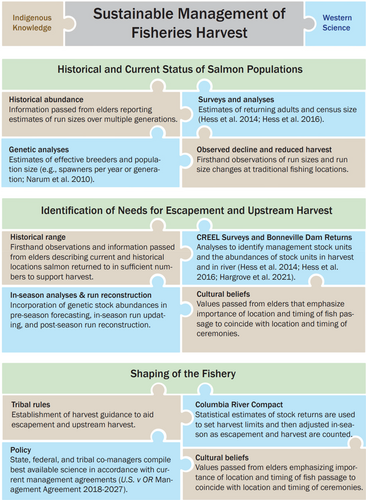
3.2 Example 2: Tribal Supplementation programs for salmonids
As salmon abundance has dwindled with several populations already extirpated (Gustafson et al. 2007), there have been extensive efforts to boost natural populations with hatchery reared fish (Figure 6; Janowitz-Koch et al., 2018). Several hatchery programs have been implemented with various approaches to achieve harvest and conservation goals (e.g. Naish et al., 2007), but tribes of the Pacific Northwest have aimed to develop supplementation hatchery programs that utilize local stocks of natural origin to reduce risks of hatchery propagation (Cuenco et al., 1993). Pairing indigenous knowledge with genetics has provided direction for this application, where tribes have long-term knowledge on the status of local salmon populations and molecular tools offer the potential to quantify recovery efforts (Figure 6). Specifically, tribal members have observed extreme declines in abundance and reduced harvest in local rivers throughout the Columbia River Basin, which has led to implementation of supplementation programs to prevent extirpation (e.g. Fast et al., 2015; Rabe & Nelson, 2010). Tribal supplementation programs have taken a rare approach to only breed local, natural-origin fish to avoid risks of domestication selection that are common in other hatchery programs (reviewed in Koch & Narum, 2021). To evaluate and track effects of tribal hatchery programs, genetic based pedigrees have been applied in several systems to directly examine reproductive success (e.g. Hess et al., 2012; Koch et al., 2022). This approach has relied on indigenous knowledge to provide insight on broodstock collection and juvenile release locations for supplementing the natural population, while genetic pedigrees have identified offspring from parents and the factors that influence successful reproduction. This pairing of knowledge has resulted in an overall boost to natural reproduction while mitigating risks.
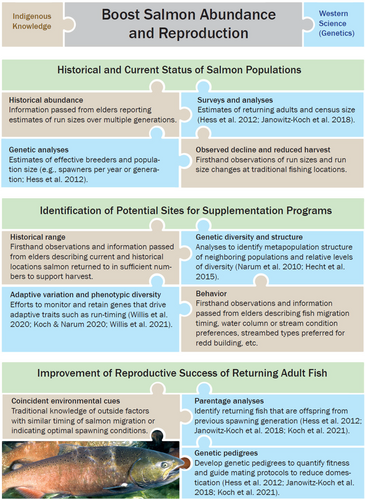
3.3 Example 3: Translocation of Pacific lamprey to historical river systems
Far too often, fisheries management, restoration and conservation tend to be structured and prioritized according to the commercial value of a species and those species that get elevated awareness tend to have high levels of financial support from advocacy groups within our modern society. The rise of the plight of Pacific Lamprey, an uncharismatic and vilified fish to the Western World, had none of the usual advantages of commercially valuable species. Nonetheless, this species has long been culturally important as a First Food of the Columbia River tribes, and further, is recognized as being a valuable component of aquatic ecosystems. For these reasons, concern over the decline of Pacific Lamprey within the Snake River in the interior Columbia River Basin was first raised and amplified from within the Columbia River tribes and led by Nez Perce tribal elder, Elmer Crow. The first step taken for Pacific Lamprey restoration was simply to return physical presence of adult spawners to the habitats they formerly occupied through translocation efforts and let these native fish assume their essential roles in the ecosystem (Figure 7; Whitlock et al., 2017). Adult Pacific Lamprey benefit the streams via delivery of marine derived nutrients, and the successful spawning of the adults can rapidly produce larvae that filter feed to help purify the water and convert nutrients to stored biomass that is utilized by other animals (Close et al., 2002). Indigenous knowledge provided information for translocation efforts including collection of adults from traditional sites, traditional methods to monitor larval ammocoetes, and historical distribution of this species. Conversations with tribal elders from the Confederated Tribes of the Umatilla Indian Reservation were used to narrow down potential sites for translocations to a set of locations upstream of where tribal elders reported seeing adult Pacific Lamprey spawning and where they harvested them (Close et al., 2004). The initial set of release sites (Asotin Creek, Lolo Creek, Newsome Creek, and Orofino Creek) utilized by the Nez Perce translocation program were chosen by tribal elder Elmer Crow who used recollections of the presence of adult Pacific Lamprey from his memory as a youth, collective knowledge from relatives he spoke with, and his own reconnaissance to survey the current condition of habitat (Crow, 2007). Further, the Satus River and Toppenish Creek translocation sites utilized by the Yakama Nation lamprey program were offered by tribal elders of the Confederated Tribes and Bands of Yakama Nation as sites inhabited by Pacific Lamprey (interviews with Meninick, J. and Jim, R. as described in Goudy & Lampman, 2018, 2019). Genetic tools have been applied effectively to monitor successful reproduction of released adults and identification of offspring at multiple life stages (e.g. Hess et al., 2022). This unified effort has brought together monitoring, evaluation, engineering of passage and habitat improvements, and biological research that was needed to help the newly restored fragments of Pacific Lamprey to “stick” in their former native reaches of spawning grounds as envisioned by tribal leaders.
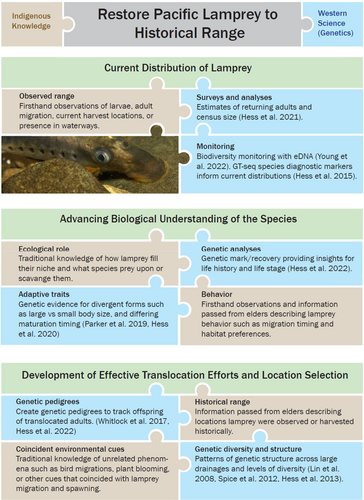
Genetic tools have also allowed for greater flexibility for the tribes to utilize translocation as a tool in the toolbox for Pacific Lamprey restoration. One of the fundamental challenges for adopting translocation more broadly for other species such as ESA-listed populations of salmonids in the Columbia River has been concerns for potential disruptions of population genetic structure from this restoration action. The lack of information on population genetic structure of Pacific Lamprey was one of the primary reasons an early petition was denied ESA listing status. Since then, tribal advocacy and support for the species generated enough early interest to initiate multiple studies on population genetic structure (Hess et al., 2012; Lin et al., 2008; Spice et al., 2012), which largely concluded that the Columbia River Basin represented a single interbreeding population of Pacific Lamprey. This genetic support for a “single population” provided some relief from concerns over the potential for translocations to disrupt population structure if Pacific Lamprey were moved across different sites within the Columbia River Basin. More recently, the Columbia River Treaty Tribes have adopted a conservative approach to translocations that sources fish from as far downstream as Bonneville Dam but not lower, to release in locations in the interior Columbia River. This guidance was also based on recent genetic analysis (Hess et al., 2014) that showed that despite the Columbia River basin acting as a single population, there were still highly divergent adaptive forms of Pacific Lamprey (i.e. large bodied and small bodied) as well as ocean- and stream-maturing ecotypes (Hess et al., 2021; Parker et al., 2019) that were segregated between the lower Columbia River and interior Columbia River portions of the basin.
In general, the initiative and prioritization of Pacific Lamprey as a species of significant cultural and ecological value, and worthy of restoration, originated within the Columbia River Treaty Tribes. The tools for restoration and locations for those efforts were directed by the tribes. Genetic technology and monitoring were used to evaluate the effectiveness and guide any limitations that might be required to use translocation actions wisely (Hess et al., 2022). However, at each step, it was the tribal objectives and prioritization for restoration of this culturally important species that shaped directions of management actions.
4 AIMS FOR LONG-TERM PERSISTENCE OF NATIVE FISHES AND THE ECOSYSTEM
Fisheries ecology of the Columbia River ecosystem is considered complex under western scientific concepts and recovery of native fishes is hampered by conflicting policies (e.g. conservation of exclusively wild populations versus supportive breeding programs intended to prevent population extirpation). In contrast, protection of native fisheries from an indigenous perspective generally follows the holistic principal of mutual caretakers: “If we take care of the fish, the fish will take care of us”. Tribal cultures and traditions are an inherent part of the Columbia River ecosystem with aims of long-term species persistence for greater than seven generations. Efforts led by tribal fisheries programs are intensively focused on maintaining fisheries for future needs and utilize a paired approach with indigenous knowledge and Western science, each providing unique guidance to reach objectives including development of genetic monitoring tools. The benefits of multiple knowledge sources are evident as described in the specific examples above. Indigenous knowledge ensures that information from past generations will be applied to current and future generations. In parallel, genetically diverse populations will be needed to adapt to effects of climate change and other habitat disruption to enable long-term persistence.
ACKNOWLEDGEMENTS
This study was informed by several tribal members that shared facets of millennia of history and traditions of their cultures throughout the Columbia River Basin, but the content here is not comprehensive of tribal perspectives throughout the region. Eric Quaempts (Umatilla tribal elder) provided guidance on First Foods concept. Fred Hill (Umatilla tribal elder) translated the abstract to native Sahaptin language (Appendix S1). This work is dedicated in memory of Elmer Crow (Nez Perce tribal elder) and Bobby Begay (Yakama Nation tribal elder) for their tireless efforts towards fisheries recovery in the Columbia River Basin.
CONFLICT OF INTEREST STATEMENT
The authors have no conflict of interest to declare.
BENEFIT-SHARING STATEMENT
This study provides insights and further examples of applications with both Indigenous Knowledge and Western Science that contribute to conservation and recovery of native species.
Open Research
DATA AVAILABILITY STATEMENT
The data in this study were synthesized from previous publications and are available from the repository stated in those papers.



